Stars/Astronomy
< Stars
"A star is a massive, luminous sphere of plasma held together by gravity."[1]
Astronomy
A nomy (Latin nomia) is a "system of laws governing or [the] sum of knowledge regarding a (specified) field."[2]
When any effort to acquire a system of laws or knowledge focusing on an astr, aster, or astro, that is, any natural body in the sky especially at night,[2] succeeds even in its smallest measurement, astronomy is the name of the effort and the result.
While natural objects in the sky, especially at night, may be sensed by sight, sound, smell, taste, or touch (vibration), many have been seen from the light they emit, absorb, reflect, transmit, or fluoresce.
Some of the natural emitters are stars.
Stars
Def. a "luminous celestial body, made up of plasma (particularly hydrogen and helium) and having a spherical shape"[3] is called a star.
"Depending on context the sun may or may not be included."[3]
Colors
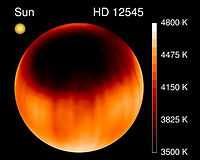
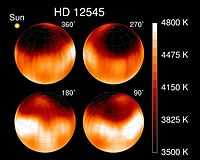
"Our Sun itself frequently has sunspots, relatively cool dark magnetic depressions that move across its surface. HD 12545, however, exhibits the largest starspots yet observed. Doppler imaging - the use of slight changes in color caused by the rotation of the star - was used to create this false-color image. The vertical bar on the right gives a temperature scale in kelvins. This giant, binary, RS CVn star, also known as XX Trianguli, is visible with binoculars in the constellation of Triangulum. The starspot is thought to be caused by large magnetic fields that inhibit hot matter from flowing to the surface."[4]
"A giant starspot was revealed on the K0 giant star XX Triangulum, also known as HD12545, using Doppler imaging on the Kitt Peak National Observatory's 0.9m Coude Feed telescope. This picture shows a series of views around the star".[5]
"To observe spots on the surfaces of other stars, astronomers need to "resolve" the stellar disk. This cannot be done directly with the largest telescopes even planned, but Doppler imaging can be used to obtain a map of inhomogeneities on a star's surface. The principle is similar to medical tomography, but instead of a scanner rotating around a fixed object, a rotating star is observed with a fixed telescope. A cool starspot rotating into view at the preceding limb of the star causes a blue-shifted asymmetry in each spectral line profile. This asymmetry moves into the line center at the time of meridian passage, and turns into a red-shifted asymmetry after meridian passage. The asymmetry fades away when the spot disappears at the receding limb. The higher the latitude of the spot, the shorter will be its visible path across the projected disk of the star, or the spot may even be circumpolar if the stellar rotation axis is inclined. All this information is hidden in the variation of the spectral line profiles and is reconstructed by mathematical inversion to create a true picture of the stellar surface. For a successful application, the telescope needs to "see" the entire stellar surface during at least one stellar rotation."[6]
"XX Triangulum is an active K0 giant binary star, approximately 10 times larger and twice as massive as the Sun. Its rotation period is 24 days, so that 24 consecutive (clear) nights of telescope time with an excellent high-resolution optical spectrograph are needed to obtain a good Doppler image. Because starspots vary on the same (short) time scales as Sunspots do (they are stable for about one stellar rotation), all the observations must be made on one rotation cycle. NSF's Kitt Peak National Observatory is one of the few facilities worldwide that offers this capability with the 0.9-m coude feed telescope."[6]
"During the observations, XX Triangulum had its brightest magnitude since the discovery of its light variability in 1985 and showed the largest photometric amplitude so far (0.63 magnitudes in V). The large photometric amplitude was explained when the Doppler-imaging inversion algorithm also recovered a not-quite-as-large equatorial warm spot (350 K above the photospheric temperature) in the hemisphere opposite the dark spot. Strassmeier speculates that the warm spot harbors the same magnetic field as the cool spot but opposite polarity. Surprisingly, the fact that the star was brighter at a time of high spot activity is in agreement with the solar analogy despite the "unsolar" dimension of the gigantic spot."[6]
Theoretical stellar astronomy
As stars are defined as luminous balls of plasma, the Sun may not qualify as its photosphere has a plasma concentration of approximately 10-4. The rest is composed of neutral atoms at about 5800 K.
Theta Ursae Majoris
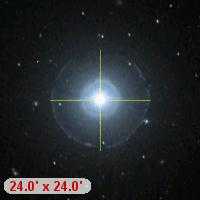
Theta Ursae Majoris is a spectral type F7V star.[7] It has a surface temperature of 6300 ± 33 K.[8] Such an effective surface temperature has a Planckian black body peak wavelength of 476 nm which places this star at the high temperature end of the cyan band.
IRC +10420
"IRC +10420 ... is a peculiar F8I+ hypergiant with a large far-infrared excess attributed to circumstellar dust"[9]. The Brα, Pfγ, and Brγ lines are in emission, "with Hα showing a double peaked profile".[9] A Teff range of 6000 K to 6500 K fit the spectral photometry.[9] A Teff range of ~6060 K to ~6300 K is a cyan star. "Based on the model fit, the contribution of the photosphere at the observed wavelengths is: ... Brγ (60%), Pfγ (8%), and Brα (6%), the rest of the continuum emission is due to thermally radiating dust."[9]
Beta Virginis

Beta Virginis has a surface Teff = 6,132 ± 26.[10] According to SIMBAD, beta Virginis is a high proper-motion star with spectral type equal to F9V. Beta Virginis is also known as LHS 2465, GJ 449, HD 102870, and HR 4540. It is an X-ray source per 2E,RBS,RX,1RXS, and is a double star.
Alpha Centauri A
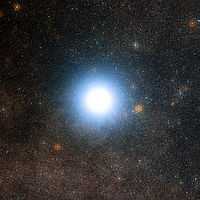
"Alpha Centauri A is the principal member, or primary, of the binary system, being slightly larger and more luminous [151.9% the luminosity of the Sun] than the Sun. It is a solar-like main sequence star with a similar yellowish color,[11] [surface temperature of 5790 K][12] whose stellar classification is spectral type G2 V.[13] From the determined mutual orbital parameters, Alpha Centauri A is about 10% more massive than the Sun, with a radius about 23% larger.[12] The projected rotational velocity ( v·sin i ) of this star is 2.7 ± 0.7 km·s−1, resulting in an estimated rotational period of 22 days,[14] which gives it a slightly faster rotational period than the Sun's 25 days."[15]
Capella B
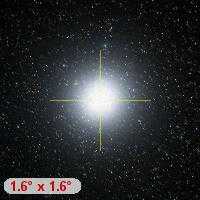
Capella B "has a surface temperature of approximately 5700 K, a radius of approximately 9 solar radii, a mass of approximately 2.6 solar masses, and a luminosity, again measured over all wavelengths, approximately 78 times that of the Sun.[16]"[17]
Capella B is spectral type G0III star and an X-ray source from the catalog [FS2003] 0255 by ROSAT. Its surface temperature has an uncertainty of 100 K. It is part of a binary star with Capella A a G8III. From SIMBAD, the orbital period is 104.0217 d with an eccentricity is 0.001 and inclination of 137.2° to the line of sight.
Although the binary star Capella is not an eclipsing binary, it is a RS Canum Venaticorum variable. These "are close binary stars[18] having active chromospheres which can cause large stellar spots. These spots are believed to cause variations in their observed luminosity. Systems can exhibit variations on timescales of years due to variation in the spot surface coverage fraction, as well as periodic variations which are, in general, close to the orbital period of the binary system. ... Typical brightness fluctuation is around 0.2 magnitudes."[19]
TW Hydrae
"TW Hydrae, a [K8V spectral type] star 176 light-years from Earth in the constellation Hydra ... which has about the same mass as the sun, is surrounded by a dense ring of gas and dust. ... Its circumstellar disk is estimated to between 3 million and 10 million years old, and most protoplanetary disks are thought to last only 2 million to 3 million years. ... [Using the] ESA's Herschel Space Telescope, which is sensitive to the required infrared wavelengths [to measure the amount of deuterium] ... The ratio of deuterium to hydrogen appears constant in Earth's region of space, which means ... measuring hydrogen deuteride [yields] how much regular molecular hydrogen is present. ... TW Hydrae's disk is at least 16,650 times the mass of the Earth. Considering the planets in the solar system may have arisen from a disk only as little as 3,300 times the mass of the Earth, the matter in TW Hydrae's disk would be ample to form a planetary system. "This ... seems to point towards different systems finding disparate pathways to making planets." "If there's no chance your project can fail, you're probably not doing very interesting science," ... Signs of hydrogen deuteride remain difficult to detect around distant stars"[20].
AZ Cancri
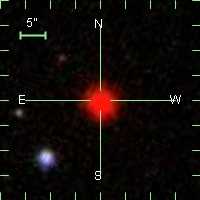
At right is a close-up of the SDSS DR6 image of AZ Cancri in real (visual) color. According to SIMBAD, AZ Cancri (AZ Cnc) is a spectral type M6.0V flare star, that is also an X-ray source detected by the ROSAT satellite. AZ Cancri (AZ Cnc) is a M-type flare star in the constellation Cancer.[21] It has an apparent visual magnitude of approximately 17.59.[21]
Astrometry
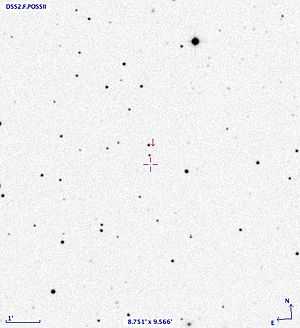
The star is in NGC 2632 designated Haro, Chavira, and Gonzalez (HCG) 4.[22] NGC 2632 is an open cluster, also called Messier 44, and the Praesepe Cluster.
The X-ray astronomy satellite ROSAT detected AZ Cnc at RX J0840.4+1824 and 1RXS J084029.9+182417.
In the SIMBAD visual sky plot at right, AZ Cnc is immediately at the tip of the red arrow J2000.0 RA 08h 40m 29.751s Dec +18°24'09.18".
Regarding the NED image at left AZ Cnc is located at J2000.0 RA 08h 40m 30.2s Dec +18°23'55", precisely coincident with the negative visual object image at exact image center.
Astronomical visual sources

The visual star is spectral type M6e,[23] specifically M6.5Ve.[24] Visual magnitude is Mv = 16.9. log Lbol = 30.48 ergs/s (or 3.020 x 1030 ergs s-1).
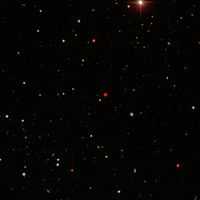
A comparison of images between that from SIMBAD at upper right and the NASA/IPAC Extragalactic Database (NED) (5' x 5') at upper left shows some identical visual object patterns. In the NED image at left are two objects very close together. These two are near the center of the southeast quarter of the SIMBAD image. To the east-southeast of the NED designated AZ Cnc is an apparently solitary visual object that is also in the NED image. In the north-east quadrant of the NED image are four visual objects forming a triangle with a weak source just above two of the objects. This pattern is repeated on the SIMBAD image which includes a fifth object forming a diamond with the objects of the triangle.
Physical characteristics
AZ Cnc is considered a very low mass star (VLMS). Distance from the Sun is 14.0 pc.[25] The radial velocity of LHS 2034 is 64.2±0.6 km/s.[26] Its galactic motion (space velocities) are U = -60.6 km/s, V = -44.3 km/s, and W = -8.3 km/s, relative to the local standard of rest.[26] LHS 2034 belongs kinematically to the old disk.[26] Its rotational velocity is v sin(i) = 7.9±2.8 km/s.[26]
Catalog designations
CSI+18-08377 is the Catalog of Stellar Identifications.[27]
GJ 316.1 is the catalog entry from the nearby star data published between 1969-1978 for numbers 2001-2159 and incorporating the earlier Catalogue of nearby stars by Gliese.[28]
LHS 2034 is the Luyten-H-S Catalogue number.[29]
Astronomical X-ray sources
The X-ray luminosity log (Lx) = 27.40 ergs/s (or 2.512 x 1027 ergs s-1).[30] Lx/Lbol = 8.318 x 10-4 does not depend on Mv, at least for older stars like AZ Cnc.[30]
Flarings
The X-ray luminosity of AZ Cnc increased by at least two orders of magnitude during a flare that lasted more than 3 h and reached a peak emission level of more than 1029 ergs/s.[30] During another long duration flare (March 14, 2002) on LHS 2034, very strong wing asymmetries occurred in all lines of the Balmer series and all strong He I lines, but not in the metal lines.[26] LHS 2034 was observed for 1.5 h on March 14, 2002, and 40 m on March 16, 2002.[26]
The flaring atmosphere of LHS 2034 has been modeled with the PHOENIX atmosphere code,[31][26] consisting of
- an underlying photosphere,
- a linear temperature rise vs. log column mass in the chromosphere, and
- transition region (TR) with different gradients.[26]
For the underlying photosphere, Teff = 2800 K, log g = 5.0, and a solar chemical composition was used.[26] The last spectrum taken in the series after the flare was used for the quiescent chromosphere.[26]
The line asymmetries have been attributed to downward moving material,[26] specifically a series of flare-triggered downward moving chromospheric condensations, or chromospheric downward condensations (CDC)s as on the Sun.[32] For the Sun such events can last a few minutes, but for LHS 2034 they have lasted for 1.5 h.[26]
Theory of coronal heating
The electrodynamic coupling theory of coronal heating developed in a solar context,[33] has been applied to stellar coronae.[34] A distinctive feature is the occurrence of a resonance between the convective turnover time and the crossing time for Alfvén waves in a coronal loop. The resonance attains a maximum among the early M dwarf spectral types and declines thereafter. A turnover in coronal heating efficiency, presumably manifested by a decrease in Lx/Lbol, becomes evident toward the late M spectral types when the theory is applicable. This is consistent with an apparent lack of X-ray emission among the late M dwarfs.[35] Coronal heating efficiencies do not decrease toward the presumably totally convective stars near the end of the main sequence.[30] For "saturated" M dwarfs, 0.1% of all energy is typically radiated in X-rays, while for AZ Cnc this number increases during flaring to 7%.[30] So far there is no evidence to suggest that AZ Cnc is less efficient than more massive dwarfs in creating a corona.[30] The saturation boundary in X-ray luminosity extends to late M dwarfs, with Lx/Lbol ~ 10−3 for saturated dwarfs outside flaring. No coronal dividing line exists in the Hertzsprung–Russell diagram at the low-mass end of the main sequence.[30]
AZ Cnc casts doubt on the applicability of electrodynamic coupling as there is no evidence for a sharp drop in Lx/Lbol when compared with other late M stars at least until subtype M8.[30]
Dynamos
AZ Cnc has a corona and this may indicate that a distributive dynamo is just as efficient in producing magnetic flux as a shell dynamo.[30] Between the generation of a magnetic field and the emission of X-rays lies the coronal heating mechanism.[30]
SY Persei
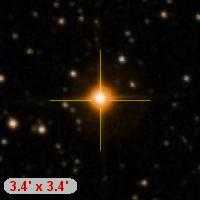
The variability of BD +50 961 (SY Persei, an orange star, spectral type C6,4e) is confirmed.[36]
Astrophysics
Def. "any object forming on a dynamical timescale, by gravitational instability", is called a star.[37]
Sciences
"[S]tellar classification is a classification of stars based on their spectral characteristics. The spectral class of a star is a designated class of a star describing the ionization of its chromosphere, what atomic excitations are most prominent in the light, giving an objective measure of the temperature in this chromosphere."[38]
"[T]he luminosity class [is] expressed by the Roman numbers I, II, III, IV and V, expressing the width of certain absorption lines in the star's spectrum."[38]
| Class | Temperature[39] K |
Conventional color | Apparent color[40][41][42] | Mass[39] (solar masses, Mʘ) |
Radius[39] (solar radii, Rʘ) |
Luminosity[39] (bolometric, Lʘ) |
Hydrogen lines |
Fraction of all main sequence stars[43] |
|---|---|---|---|---|---|---|---|---|
| O | ≥ 33,000 K | blue | blue | ≥ 16 | ≥ 6.6 | ≥ 30,000 | Weak | ~0.00003% |
| B | 10,000–33,000 K | blue to blue white | blue white | 2.1–16 | 1.8–6.6 | 25–30,000 | Medium | 0.13% |
| A | 7,500–10,000 K | white | white to blue white | 1.4–2.1 | 1.4–1.8 | 5–25 | Strong | 0.6% |
| F | 6,000–7,500 K | yellowish white | white | 1.04–1.4 | 1.15–1.4 | 1.5–5 | Medium | 3% |
| G | 5,200–6,000 K | yellow | yellowish white | 0.8–1.04 | 0.96–1.15 | 0.6–1.5 | Weak | 7.6% |
| K | 3,700–5,200 K | orange | yellow orange | 0.45–0.8 | 0.7–0.96 | 0.08–0.6 | Very weak | 12.1% |
| M | ≤ 3,700 K | red | orange red | ≤ 0.45 | ≤ 0.7 | ≤ 0.08 | Very weak | 76.45%.[38] |
Original research
- See also: Original research inquiry and Research
Hypothesis:
- Any astronomical object with a luminescent photosphere is a star.
- See also: Control groups, Proof of concept, and Proof of technology
See also
References
- ↑ "Star, In: Wikipedia". San Francisco, California: Wikimedia Foundation, Inc. June 18, 2012. Retrieved 2012-06-26.
- 1 2 Philip B. Gove, ed (1963). Webster's Seventh New Collegiate Dictionary. Springfield, Massachusetts: G. & C. Merriam Company. pp. 1221.
- 1 2 "star, In: Wiktionary". San Francisco, California: Wikimedia Foundation, Inc. July 6, 2013. Retrieved 2013-07-17.
- ↑ Robert Nemiroff & Jerry Bonnell (November 2, 2003). "Astronomy Picture of the Day". Washington, DC USA: NASA. Retrieved 2014-08-31.
- ↑ K. Strassmeier (November 2, 2003). "Giant starspot". NOAO. Retrieved 2014-08-31.
- 1 2 3 Caty Pilachowski (December 1999). "XX Marks the Spot". NOAO Newsletter (60). NOAO. Retrieved 2014-08-31.
- ↑ Helmut A. Abt (January 2009). "MK Classifications of Spectroscopic Binaries". The Astrophysical Journal Supplement 180 (1): 117–8. doi:10.1088/0067-0049/180/1/117.
- ↑ Tabetha S. Boyajian,; McAlister, Harold A.; van Belle, Gerard; Gies, Douglas R.; ten Brummelaar, Theo A.; von Braun, Kaspar; Farrington, Chris; Goldfinger, P. J. et al. (February 2012). "Stellar Diameters and Temperatures. I. Main-sequence A, F, and G Stars". The Astrophysical Journal 746 (1): 101. doi:10.1088/0004-637X/746/1/101.. See Table 10.
- 1 2 3 4 René D. Oudmaijer, T.R. Geballe, L.B.F.M. Walters, and K.C. Sahu. "Discovery of near-infrared hydrogen line emission in the peculiar F8 hypergiant IRC +10420". Astronomy and Astrophysics 281 (1): L33-6.
- ↑ Tabetha S. Boyajian, Harold A. McAlister, Gerard van Belle, Douglas R. Gies, Theo A. ten Brummelaar, Kaspar von Braun, Chris Farrington, P. J. Goldfinger, David O'Brien, J. Robert Parks, Noel D. Richardson, Stephen Ridgway, Gail Schaefer, Laszlo Sturmann, Judit Sturmann, Yamina Touhami , Nils H. Turner, Russel White (February 2012). "Stellar Diameters and Temperatures. I. Main-sequence A, F, and G Stars". The Astrophysical Journal 746 (1): 101. doi:10.1088/0004-637X/746/1/101.. See Table 10.
- ↑ "The Colour of Stars". Australia Telescope, Outreach and Education. Commonwealth Scientific and Industrial Research Organisation. December 21, 2004. Retrieved 2012-01-16.
- 1 2 Kervella, Pierre; Thevenin, Frederic (March 15, 2003). "A Family Portrait of the Alpha Centauri System". ESO. Archived from the original on 16 June 2008. Retrieved 2008-06-06.
- ↑ Research Consortium on Nearby Stars (2007-09-17). "The One Hundred Nearest Star Systems". RECONS. Georgia State University. Archived from the original on 12 November 2007. Retrieved 2007-11-06.
- ↑ Bazot, M.; et al. (2007). "Asteroseismology of α Centauri A. Evidence of rotational splitting". Astronomy and Astrophysics 470 (1): 295–302. doi:10.1051/0004-6361:20065694.
- ↑ "Alpha Centauri, In: Wikipedia". San Francisco, California: Wikimedia Foundation, Inc. January 22, 2013. Retrieved 2013-01-22.
- ↑ C. A. Hummel et al. (May 1994). "Very high precision orbit of Capella by long baseline interferometry". The Astronomical Journal 107 (5): 1859–67. doi:10.1086/116995.
- ↑ "Capella, In: Wikipedia". San Francisco, California: Wikimedia Foundation, Inc. January 5. 2013. Retrieved 2013-01-22.
- ↑ Berdyugina 2.4 RS CVn stars
- ↑ "RS Canum Venaticorum variable, In: Wikipedia". San Francisco, California: Wikimedia Foundation, Inc. July 18, 2012. Retrieved 2012-11-09.
- ↑ Charles Q. Choi (January 30, 2013). "Star Not Too Old to Have Planets After All". Yahoo! News. Retrieved 2013-01-31.
- 1 2 Template:SIMBAD link, database entry, SIMBAD. Accessed on line October 13, 2010.
- ↑ Haro G, Chavira E, Gonzalez G (Dec 1976). "Flare stars in the Praesepe field". Bol Inst Tonantzintla. 2 (12): 95–100.
- ↑ Kirkpatrick JD, Henry TJ, McCarthy D (1991). "A standard stellar spectral sequence in the red/near-infrared - Classes K5 to M9". Ap J Suppl Ser. 77: 417. doi:10.1086/191611.
- ↑ Dahn C, Green R, Keel W, Hamilton D, Kallarakal V, Liebert J (Sep 1985). "The Absolute Magnitude of the Flare Star AZ Cancri (LHS 2034)". Information Bull Var Stars. 2796 (9): 1–2.
- ↑ Monet DG, Dahn CC, Vrba FJ, Harris HC, Pier JR, Luginbuhl CB, Ables HD (1992). "U.S. Naval Observatory CCD parallaxes of faint stars. I - Program description and first results". Astron J. 103: 638. doi:10.1086/116091.
- 1 2 3 4 5 6 7 8 9 10 11 12 Fuhrmeister B, Schmitt JHMM, Hauschildt PH (Jun 2005). "Detection of red line asymmetries in LHS 2034". Astron Astrophys. 436 (2): 677–86. doi:10.1051/0004-6361:20042518. http://www.aanda.org/index.php?option=article&access=standard&Itemid=129&url=/articles/aa/full/2005/23/aa2518-04/aa2518-04.html.
- ↑ Ochsenbein F, Bischoff M, Egret D (Feb 1981). "Microfiche edition of CSI". Astron Astrophys Suppl Ser. 43 (2): 259–64.
- ↑ Gliese W, Jahreiss H (1979). "Nearby star data published 1969-1978". Astron Astrophys Suppl Ser. 38: 423–48.
- ↑ Luyten WJ (1979). LHS Catalogue. Minneapolis: University of Minnesota.
- 1 2 3 4 5 6 7 8 9 10 Fleming TA, Giampapa MS, Schmitt JHMM, Bookbinder JA (Jun 1993). "Stellar coronae at the end of the main sequence - A ROSAT survey of the late M dwarfs". Ap J. 410 (1): 387–92. doi:10.1086/172755.
- ↑ Hauschildt PH, Allard F, Baron E (Feb 1999). "The NextGen Model Atmosphere Grid for 3000<=T_eff<=10,000 K". Ap J. 512 (1): 377–85. doi:10.1086/306745.
- ↑ Fisher GH (Nov 1989). "Dynamics of flare-driven chromospheric condensations". Ap J. 346 (11): 1019–29. doi:10.1086/168084.
- ↑ Ionson J (1984). Ap J. 306: 357.
- ↑ Mullan DJ (1984). "On the possibility of resonant electrodynamic coupling in the coronae of red dwarfs". Ap J. 282: 603. doi:10.1086/162239.
- ↑ Bookbinder JA (1985) (Thesis). Harvard University.
- ↑ T. W. Backhouse (July 1899). "Confirmed or New Variable Stars". The Observatory 22 (281): 275-6.
- ↑ Anthony Whitworth, Dimitri Stamatellos, Steffi Walch, Murat Kaplan, Simon Goodwin, David Hubber and Richard Parker (2009). R. de Grijs & J. R. D. Lépine. ed. The formation of brown dwarfs, In: Star clusters: basic galactic building blocks, Proceedings IAU Symposium No. 266. International Astronomical Union. pp. 264-71. doi:10.1017/S174392130999113X. http://journals.cambridge.org/download.php?file=%2FIAU%2FIAU5_S266%2FS174392130999113Xa.pdf&code=410ba8317302679d01f7ea49a2a202a6. Retrieved 2011-10-30.
- 1 2 3 "Stellar classification, In: Wikipedia". San Francisco, California: Wikimedia Foundation, Inc. August 8, 2012. Retrieved 2012-08-08.
- 1 2 3 4 Tables VII, VIII, Empirical bolometric corrections for the main-sequence, G. M. H. J. Habets and J. R. W. Heinze, Astronomy and Astrophysics Supplement Series 46 (November 1981), pp. 193–237, bibcode=1981A&AS...46..193H. Luminosities are derived from Mbol figures, using Mbol(ʘ)=4.75.
- ↑ The Guinness book of astronomy facts & feats, Patrick Moore, 1992, 0-900424-76-1
- ↑ "The Colour of Stars". Australia Telescope Outreach and Education. 2004-12-21. Retrieved 2007-09-26. — Explains the reason for the difference in color perception.
- ↑ What color are the stars?, Mitchell Charity. Accessed online March 19, 2008.
- ↑ Glenn LeDrew (February 2001). "The Real Starry Sky". Journal of the Royal Astronomical Society of Canada 95 (1 (whole No. 686, February 2001), pp. 32–33. Note: Table 2 has an error and so this article will use 824 as the assumed correct total of main-sequence stars). http://adsabs.harvard.edu/abs/2001JRASC..95...32L.
External links
- African Journals Online
- Bing Advanced search
- Google Books
- Google scholar Advanced Scholar Search
- International Astronomical Union
- JSTOR
- Lycos search
- NASA/IPAC Extragalactic Database - NED
- NASA's National Space Science Data Center
- Office of Scientific & Technical Information
- PubChem Public Chemical Database
- Questia - The Online Library of Books and Journals
- SAGE journals online
- The SAO/NASA Astrophysics Data System
- Scirus for scientific information only advanced search
- SDSS Quick Look tool: SkyServer
- SIMBAD Astronomical Database
- SIMBAD Web interface, Harvard alternate
- Spacecraft Query at NASA.
- SpringerLink
- Taylor & Francis Online
- Universal coordinate converter
- Wiley Online Library Advanced Search
- Yahoo Advanced Web Search
![]() This is a research project at http://en.wikiversity.org
This is a research project at http://en.wikiversity.org
| |
Educational level: this is a research resource. |
| |
Resource type: this resource is an article. |
| |
Resource type: this resource contains a lecture or lecture notes. |
| |
Subject classification: this is an astronomy resource. |